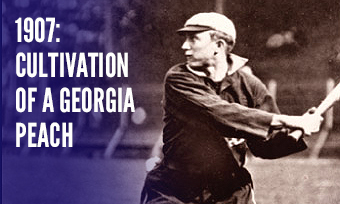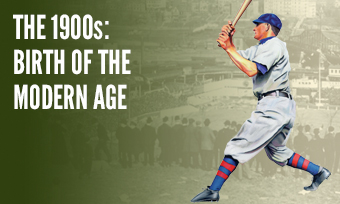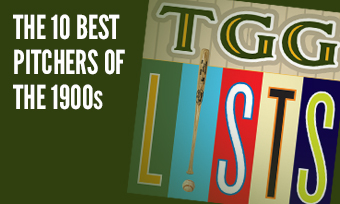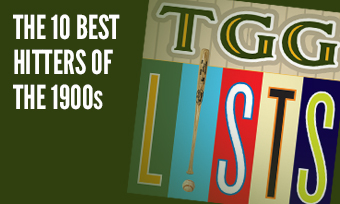The Yearly Reader
Leaders and Honors, 1907
Our list of baseball’s top 10 hitters and pitchers in both the American League and National League for the 1907 baseball season, as well as the awards and honors given to the game’s top achievers of the year.
The National League’s Top 10 Hitters, 1907
Bold type in brick red indicates league leader.
1. Honus Wagner, Pittsburgh
Key Numbers: .350 average, 98 runs, 180 hits, 38 doubles, 14 triples, 6 home runs, 82 RBIs, 61 stolen bases.
Just another year of greatness for Wagner, who among other achievements set a career high with 61 steals.
2. Sherry Magee, Philadelphia
Key Numbers: .328 average, 28 doubles, 12 triples, 4 home runs, 85 RBIs, 46 stolen bases.
Magee kept the Phillies (who hit .225 without him) from becoming the NL’s version of the Hitless Wonders.
3. Fred Clarke, Pittsburgh
Key Numbers: .289 average, 97 runs, 13 triples, 68 walks, 37 stolen bases.
After a number of years where he took time off from his playing duties to concentrate full time on managing, Clarke began a three-year period where he played almost every day, with his usual excellence.
4. Tommy Leach, Pittsburgh
Key Numbers: .303 average, 102 runs, 12 triples, 43 stolen bases.
Rebounding back to prime form, Leach was one of four Pirates with over 30 steals.
5. Ginger Beaumont, Boston
Key Numbers: .322 average, 187 hits, 14 triples, 4 home runs, 62 RBIs, 25 stolen bases.
The veteran speedster got a new lease on life in Boston after a recent injury curtailed his output in Pittsburgh.
6. Ed Abbaticchio, Pittsburgh
Key Numbers: .262 average, 82 RBIs, 65 walks, 35 stolen bases.
The man traded to the Pirates for Beaumont, Abbaticchio flourished in a winning environment after a yearlong holdout with the Beaneaters.
7. Frank Chance, Chicago
Key Numbers: 111 games, .293 average, 51 walks, 35 stolen bases.
Despite sitting out over 40 games, the Cubs’ first baseman-manager remained an A-list threat at the plate.
8. Spike Shannon, New York
Key Numbers: .265 average, 104 runs, 82 walks, 33 stolen bases.
In his one full year at New York, Shannon became a valuable leadoff spark for the Giants.
9. Cy Seymour, New York
Key Numbers: .294 average, 25 doubles, 8 triples, 3 home runs, 75 RBIs, 21 stolen bases.
Seymour’s continued strong output made it easy for Giants manager John McGraw to tell fellow star outfielder Mike Donlin to take a hike when he demanded a raise.
10. John Titus, Philadelphia
Key Numbers: .275 average, 23 doubles, 12 triples, 3 home runs, 63 RBIs.
“Silent John” let his bat do much of the talking with another strong supporting turn for the Phillies.
The American League’s Top 10 Hitters, 1907
1. Ty Cobb, Detroit
Key Numbers: .350 average, 97 runs, 212 hits, 28 doubles, 14 triples, 5 home runs, 119 RBIs, 53 stolen bases.
An AL equal to Honus Wagner finally emerged—with all due respect to Nap Lajoie—as the 20-year-old Cobb became the youngest batting champion until Al Kaline (barely) unseated him off that throne in 1954.
2. Sam Crawford, Detroit
Key Numbers: .323 average, 102 runs, 188 hits, 34 doubles, 17 triples, 81 RBIs.
Although Cobb wasn’t making too many friends in Detroit, he must have at least gotten Christmas Card consideration from Crawford, who thrived with Cobb in the lineup as protection.
3. Elmer Flick, Cleveland
Key Numbers: .302 average, 18 triples, 64 walks, 41 stolen bases.
He was dancing as fast as he could until he could dance no more: The 31-year-old Flick enjoyed his last great year, leading the AL in triples for a third straight season, before enduring a sudden decline; consistent gastritis was said to be the main issue.
4. Harry Davis, Philadelphia
Key Numbers: .266 average, 84 runs, 35 doubles, 8 home runs, 87 RBIs, 20 stolen bases.
Davis took the last of four straight sole AL home run titles, something only Babe Ruth would match in AL history.
5. George Stone, St. Louis
Key Numbers: .320 average, 77 runs, 191 hits, 11 triples, 59 walks.
The reigning AL batting champ (before Cobb began to monopolize the honor) had a slight drop-off—perhaps the result of holding out for higher salary to start the season.
6. Topsy Hartsel, Philadelphia
Key Numbers: .280 average, 93 runs, 106 walks, .405 on-base percentage.
The A’s table–setter reached double-digits in walks for the second time in his career.
7. Hal Chase, New York
Key Numbers: .287 average, 72 runs, 68 RBIs, 32 stolen bases.
Always one to crave money—illicitly or otherwise—Chase threatened to jump to an outlaw league back in his native California unless he got a raise. He apparently got it.
8. Nap Lajoie, Cleveland
Key Numbers: .301 average, 30 doubles, 2 home runs, 63 RBIs, 24 stolen bases.
Though his batting average dropped 54 points—some suggested he was entering decline at age 32—Lajoie still remained one of the AL’s most potent hitters.
9. Socks Seybold, Philadelphia
Key Numbers: .271 average, 29 doubles, 5 home runs, 92 RBIs.
An original member of the A’s, Seybold put together savvy numbers in what would be his last full-time season at age 36.
10. Eddie Hahn, Chicago
Key Numbers: .255 average, 87 runs, 84 walks.
The ultimate Hitless Wonder: A strong enough effort to make this list despite failing to reach double-digits in either doubles (9), triples (7) or home runs (0).
The National League’s Top 10 Pitchers, 1907
1. Christy Mathewson, New York
Key Numbers: 2.00 ERA, 24 wins, 12 losses, 315 innings.
Big Six restored his standing as the NL’s best pitcher after struggling the year before with a bout of diphtheria.
2. Orvie Overall, Chicago
Key Numbers: 1.68 ERA, 23 wins, 7 losses, 268.1 innings.
A strong Overall effort from Orvie, raising his record to 35-10 since a mid-1906 trade to the Cubs…after previously going 22-28 in Cincinnati.
3. Three Finger Brown, Chicago
Key Numbers: 1.39 ERA, 20 wins, 6 losses.
In a relatively modest encore to his incredible breakout showing of 1906, the real remarkable thing about Brown’s 1.39 ERA is that it was the third best figure on his own team.
4. Tully Sparks, Philadelphia
Key Numbers: 2.00 ERA, 22 wins, 8 losses, 265 innings.
The Phillies ace peaked with career highs in wins and ERA, helping to place him in his current standing as fourth on the Phillies’ all-time ERA list.
5. Jack Pfiester, Chicago
Key Numbers: 1.15 ERA, 14 wins 9 losses.
Though not as low as Brown’s remarkable 1.04 ERA of the year before, Pfiester’s 1.15 figure still ranks as the fourth best in modern NL history.
6. Bob Ewing, Cincinnati
Key Numbers: 1.73 ERA, 17 wins, 19 losses, 37 starts, 332.2 innings.
Ewing became the latest to prove that pitchers couldn’t have it both ways in the Deadball Era, setting a career low in ERA—and a career high in losses.
7. Carl Lundgren, Chicago
Key Numbers: 1.17 ERA, 18 wins, 7 losses.
After Pfiester (above), the relatively unheralded Lundgren capped a four-year run consisting of a 65-27 record with the fifth lowest ERA in modern NL history.
8. Vic Willis, Pittsburgh
Key Numbers: 2.34 ERA, 21 wins, 11 losses, 292.2 innings.
Willis continued the trend of winning 20 at Pittsburgh after repeatedly losing 20 for Boston earlier in the decade.
9. Ed Karger, St. Louis
Key Numbers: 2.01 ERA, 15 wins, 19 losses, 314 innings.
See Bob Ewing, above; among Karger’s precious win total was a seven-inning perfect game, part of a doubleheader in which both the Cardinals and Boston Doves (Braves) agreed not to play nine frames in the nightcap.
10. Sam Leever, Pittsburgh
Key Numbers: 1.66 ERA, 14 wins, 9 losses.
Despite a winning percentage below his generous .660 career mark, Leever’s ERA would represent his sole sub-2.00 figure.
The American League’s Top 10 Pitchers, 1907
1. Ed Walsh, Chicago
Key Numbers: 1.60 ERA, 24 wins, 18 losses, 56 appearances, 46 starts, 37 complete games, 422.1 innings.
Big Ed began the Herculean stage of his career by becoming only one of two AL pitchers to throw over 400 innings in a season—something he’d do again the next year.
2. Addie Joss, Cleveland
Key Numbers: 1.83 ERA, 27 wins, 11 losses, 34 complete games, 338.2 innings.
Playing the workhorse more than ever, Joss set career highs in wins, innings and complete games.
3. Cy Young, Boston
Key Numbers: 1.99 ERA, 21 wins, 15 losses, 343.1 innings.
Just when it looked like age was starting to catch up to Young, he rebounded from a 13-21, 3.19 ERA season in 1907 and became the first pitcher in major league history to win 20 games after turning 40.
4. Doc White, Chicago
Key Numbers: 2.26 ERA, 27 wins, 13 losses, 291 innings.
Overdue wins finally arrived for White, who failed to reach 20 in three previous seasons despite sub-2.00 ERAs in each.
5. Eddie Plank, Philadelphia
Key Numbers: 2.20 ERA, 24 wins, 16 losses, 8 shutouts, 40 starts, 343.2 innings.
After injuries robbed him of a fifth straight 20-win campaign by one the year before, Plank returned to full form and surpassed the milestone once more.
6. Chief Bender, Philadelphia
Key Numbers: 2.05 ERA, 16 wins, 8 losses.
The anti-workhorse, the sparingly used but always efficient Bender began to make it tougher for A’s manager Connie Mack to keep him on the bench.
7. Ed Killian, Detroit
Key Numbers: 1.78 ERA, 25 wins, 13 losses, 314 innings.
A return to form for Killian, who missed half of the previous year to injury, all despite allowing his first home run in over 1,000 innings.
8. George Winter, Boston
Key Numbers: 2.07 ERA, 12 wins, 15 losses, 256.2 innings.
Like teammate Cy Young (above), Winter enjoyed one of his more effective summers despite a losing record.
9. Harry Howell, St. Louis
Key Numbers: 1.93 ERA, 16 wins, 15 losses, 316.1 innings.
The Brooklyn native continued in his age-old struggle to earn a more deserving won-loss record to match a stellar ERA with the Browns.
10. Bill Donovan, Detroit
Key Numbers: 2.19 ERA, 25 wins, 4 losses, .862 win percentage.
No Detroit pitcher embraced the coming of Ty Cobb more than Donovan, whose already superb pitching was buoyed by six runs of support per start.









